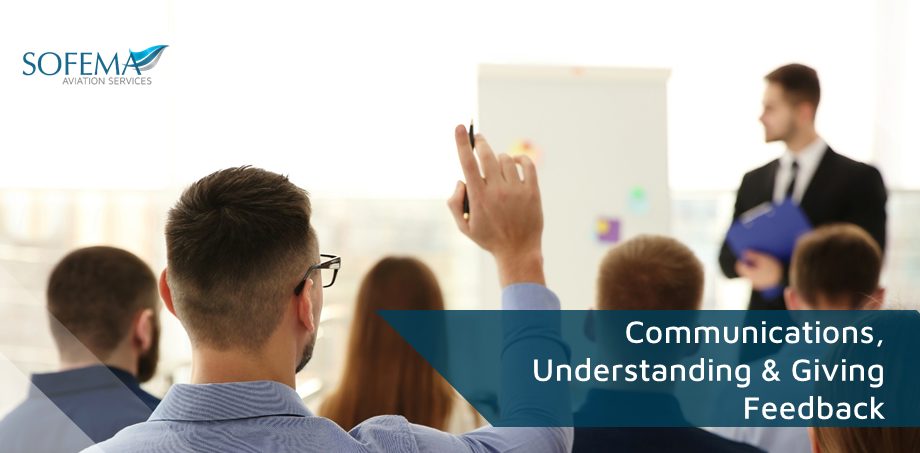Sofema Aviation Services (SAS) wwwsassofia.com considers how to improve communication effectiveness for EASA aviation instructors and to benefit from effective feedback.
Introduction
An EASA Aviation Instructor needs to be an effective communicator
- It becomes the instructor’s responsibility to relay complex aviation information to students in a clear and comprehensible manner.
- This involves having the ability to simplify technical jargon and to explain concepts in various ways to cater to different learning styles.
- In the aviation context, communication also includes understanding and effectively using the standard aviation language (English) and its phraseology.
- Miscommunications can lead to serious safety risks, so clear, concise, and accurate communication is absolutely vital.
Communication skills, like any other skills, can be improved over time. Maintain a receptive and open mind and solicit feedback from peers and trainees to continuously improve your communication skills.
Consider the following as effective primary strategies to improve communication effectiveness:
- The first step in being an effective communicator in aviation regulatory training is to have a deep understanding of the subject matter.
o EASA Aviation Instructors should be familiar with all relevant regulations and rules and should be able to explain them in a simple and clear manner.
- Use Practical Examples and note that the teaching of the application of rules and regulations can often be abstract and hard to grasp. (Complex aviation regulations can sometimes be simplified by comparing them to more familiar concepts)
o Using practical examples from real-life aviation scenarios can help illustrate these points more clearly.
Knowing Your Audience:
- Different learners have different needs and understanding levels.
o Tailoring your communication to the needs of your audience can make a big difference.
- Effective Use of Visual Aids such as diagrams, charts, and infographics can help learners understand complex topics.
- Engage your audience in the learning process.
o Ask questions,
o Encourage discussions,
o Include interactive elements in your presentations.
Repetition and Reinforcement:
Repetition is key in learning.
- Reiterate key points at different times during the training to help the information stick.
Feedback Mechanisms and Best Practice Techniques
To understand someone’s perspective or message, actively listen to what they are saying. Give your full attention, maintain eye contact, and avoid interrupting. This demonstrates respect and shows that you value their input.
If something is unclear or you need more information, don’t hesitate to ask questions. Seek clarification to ensure you have a complete understanding of the topic or the person’s viewpoint. This will help you provide more accurate and relevant feedback.
Put yourself in the other person’s shoes and try to understand their point of view. Consider their background, experiences, and emotions. Empathy helps create a safe and supportive environment for effective feedback exchange.
When giving feedback, concentrate on specific behaviors or actions rather than attacking the person’s character. Highlight the impact of their behavior, both positive and negative, and provide examples to support your feedback. Consider the following aspects:
- Regularly solicit feedback from your audience. This can help you identify areas where your communication may be lacking and make necessary adjustments.
- Feedback is essential in the learning process. A good aviation instructor provides timely, specific, and constructive feedback. They should focus on what the student did well and where improvements can be made.
- They should clearly outline the steps for improvement and guide the student in the right direction without discouraging them.
- Feedback should be a two-way event in respect of the need for EASA aviation instructors to also be open to receiving feedback from their students, as this can help improve their teaching methods.
Continuous Learning and Improvement
Remember that communication is not a one-size-fits-all approach.
- What works well for one instructor or one group of trainees might not work as well for others.
- The key is to be flexible, adaptable, and always open to learning and improving.
Next Steps
Please visit www.sassofia.com and www.sofemaonline.com – to register for a program enroll through the website or email team@sassofia.com with any questions, comments or observations.
Tags:
Best Practice Techniques, charts, Communication Skills, Communications, complete understanding, complex topics, constructive feedback, diagrams, EASA Aviation Instructor, Feedback Mechanisms, Giving Feedback, group of trainees, help learners, infographics, information stick, key points, necessary adjustments., person's viewpoint., Regulations, Repetition and Reinforcement:, safe and supportive environment, SAS blogs, teaching methods., technical jargon, Understanding, Visual Aids




